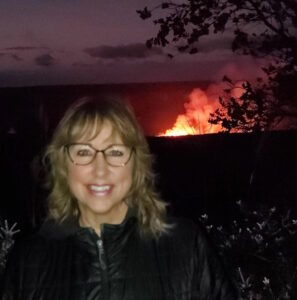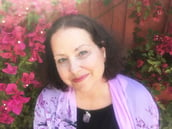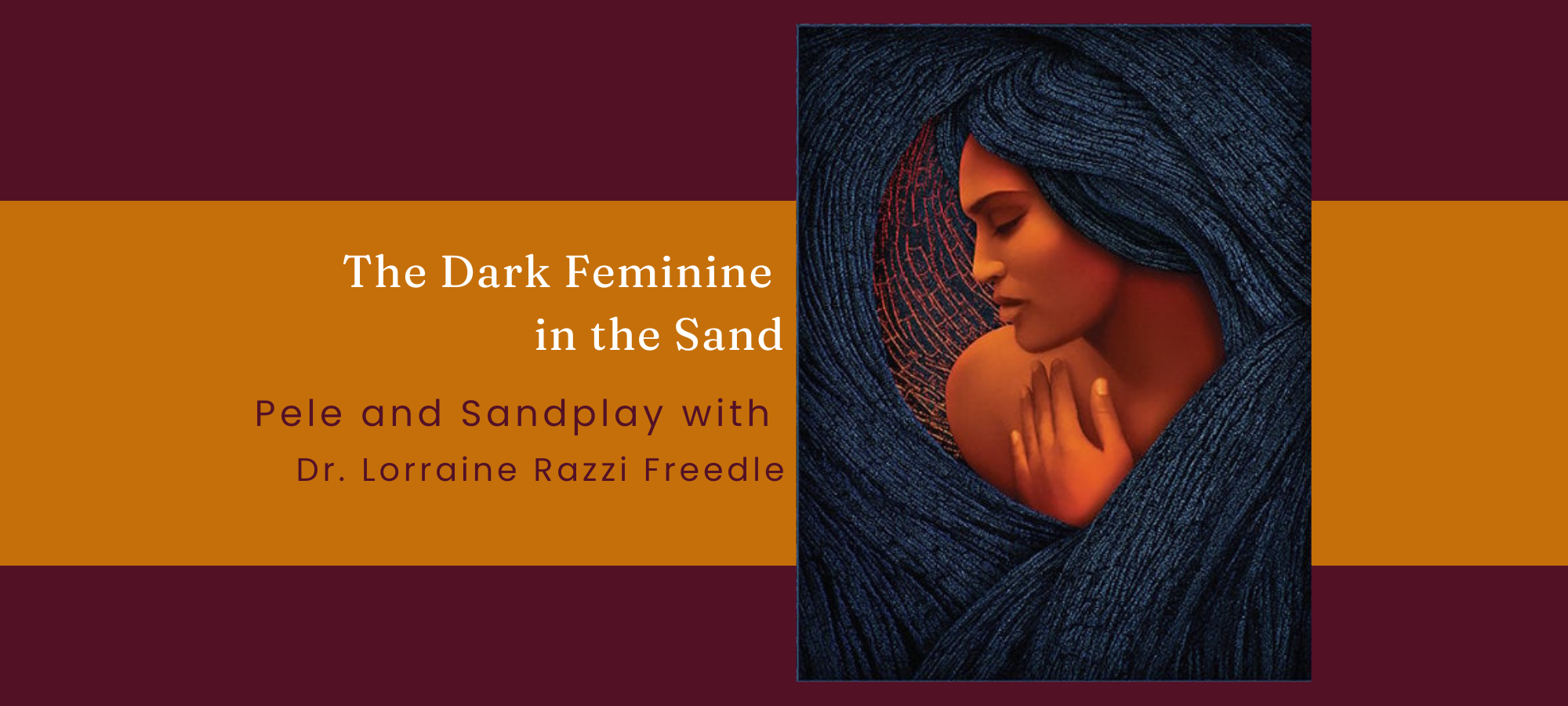Dr. Lorraine Razzi Freedle is a neuropsychologist, and sandplay teacher, as well as the author of When a Goddess Erupts: Pele in the Psyche of Women. Dr. Freedle will be teaching “Creation and Destruction: The Living Mythology of the goddess Pele in Jungian Sandplay and Psychotherapy Practice” for Pacifica Extension and International Studies, starting on June 10.
 Playing in the sand is a fundamental childhood memory of anyone raised near an ocean or lake or even a park with a sandbox. It is so associated with this, that I think most people, if they heard the term “sandplay” for the first time, would assume it’s an activity for children. Yet within depth psychology and beyond, it’s a healing modality, one which I’d like to know more about. I asked Loraine about this, and she said that sandplay is unique because “It does not reply on words. And the playing aspect makes it easy to get started, freeing the mind and opening the imagination. People engage their unconscious using their hands, sand, and miniatures. Myth comes alive.” And as one of Lorraine’s clients said, “Sandplay is like dreaming with toys.”
Playing in the sand is a fundamental childhood memory of anyone raised near an ocean or lake or even a park with a sandbox. It is so associated with this, that I think most people, if they heard the term “sandplay” for the first time, would assume it’s an activity for children. Yet within depth psychology and beyond, it’s a healing modality, one which I’d like to know more about. I asked Loraine about this, and she said that sandplay is unique because “It does not reply on words. And the playing aspect makes it easy to get started, freeing the mind and opening the imagination. People engage their unconscious using their hands, sand, and miniatures. Myth comes alive.” And as one of Lorraine’s clients said, “Sandplay is like dreaming with toys.”
I was curious to find out how Pele, sandplay, and living in Hawai’i intersected for Lorraine, who replied that “When Pele erupted in East Hawaiʻi Island in 2018, our community was in crisis. She consumed entire neighborhoods with her lava and fire. It was devastating. We brought sandplay therapy to the evacuees at the shelter and it turned out to be a perfect way to help. So many miracles happened in the sand, and I became fascinated with how the goddess Pele appeared in the sand and the psyche and how things changed when she showed up for the therapist and client alike. As a depth psychologist, I couldn’t help myself; I began writing down the stories and looking at the patterns.” From this experience came the award-winning movie, Fire and Sand, which explored people’s experiences of the eruption and how it related to Pele, finding “inner and outer landscapes of traumatic loss, hope, and new beginnings.” Next came Lorraine’s recently released book, When a Goddess Erupts: Pele in the Psyche of Women from Analytical Psychology Press. Her book explores “the interplay of myth, nature and psyche and the healing power of sandplay therapy” as well as the ways that Pele has appeared in Lorraine’s decades of psychotherapy practice.
People I’ve met who’ve spent time on Maui, and it’s been my experience too, have all said that that Pele is intense, that you may go to the islands thinking it will be fun and relaxing, but there is a powerful force of transformation there, which isn’t always fun, but will offer profound healing. Whether that is the spirit of the land, plants, and sea, or something other, I don’t know. But to me, this goes beyond talking about Pele as a myth that we can work with, and views Pele as a living, breathing energy. I asked Lorraine if this resonated with her, and she replied, “Yes, absolutely. Pele’s energy is palpable in the Hawaiian Islands. She is nature. She is alive in the ʻāina (land) and alive in all of us. When people visit the islands, they can feel her rising up from the earth, shaping inner and outer landscapes. Whether they know Pele’s mythology just doesn’t matter. Her archetypal energies are stirring in the unconscious waiting to be summoned. Being here in Hawaiʻi can certainly activate these energies and huli (turn upside down) our lives.”
 Lorraine’s course “Creation and Destruction: The Living Mythology of the goddess Pele in Jungian Sandplay and Psychotherapy Practice” for Pacifica Extension and International Studies explores Pele in depth, and I was particularly interested in the segment titled “The Dark Feminine in the Sand,” which views Pele as part of a “pantheon of dark goddesses that connect psyche to the body and the natural rhythms of life.” My mind immediately went to the dark feminine as somehow in polarity with the gentle, nurturing vision of femininity that is often held up as an ideal. When I asked Lorraine how she views the dark goddess Pele, she replied, “Pele is part of the pantheon of dark goddesses—she is fierce, jealous, and destructive. She gives voice to aspects of being a woman that are often denied expression. What people often do not know, is that her story is not complete without her younger sister, Hi’iaka. When Pele is exiled from Tahiti and voyages across the Pacific Ocean to find a home for her fire and her clan, she takes her baby sister with her who is still in an egg form. She keeps her sister safe by tucking the egg close to her heart. When Hiʻiaka hatches in Hawaiʻi, she becomes a goddess with magical healing powers, and she is associated with reforestation. So Pele has a maternal nature, too. It is said that there is no Pele without Hiʻiaka. The cycle goes on and on—Pele erupts, destroys, and creates new land, then Hiʻiaka follows with her healing energies, making the land fertile and causing new growth. This is the process in the myth and it is also reflected in nature. After the lava consumes everything in its path, it becomes fertile land.”
Lorraine’s course “Creation and Destruction: The Living Mythology of the goddess Pele in Jungian Sandplay and Psychotherapy Practice” for Pacifica Extension and International Studies explores Pele in depth, and I was particularly interested in the segment titled “The Dark Feminine in the Sand,” which views Pele as part of a “pantheon of dark goddesses that connect psyche to the body and the natural rhythms of life.” My mind immediately went to the dark feminine as somehow in polarity with the gentle, nurturing vision of femininity that is often held up as an ideal. When I asked Lorraine how she views the dark goddess Pele, she replied, “Pele is part of the pantheon of dark goddesses—she is fierce, jealous, and destructive. She gives voice to aspects of being a woman that are often denied expression. What people often do not know, is that her story is not complete without her younger sister, Hi’iaka. When Pele is exiled from Tahiti and voyages across the Pacific Ocean to find a home for her fire and her clan, she takes her baby sister with her who is still in an egg form. She keeps her sister safe by tucking the egg close to her heart. When Hiʻiaka hatches in Hawaiʻi, she becomes a goddess with magical healing powers, and she is associated with reforestation. So Pele has a maternal nature, too. It is said that there is no Pele without Hiʻiaka. The cycle goes on and on—Pele erupts, destroys, and creates new land, then Hiʻiaka follows with her healing energies, making the land fertile and causing new growth. This is the process in the myth and it is also reflected in nature. After the lava consumes everything in its path, it becomes fertile land.”
One of the things Pacifica hopes students of this class will come away with is an ability to “assess the evolution of symbols in dreams, personal narratives, and sandplay that may relate to the goddess Pele and one’s inner volcanology.” I had to know what inner volcanology is and whether or not Pele and the metaphor of a volcano might help us to experience emotions like anger in a way that is productive rather than destructive. Lorraine pointed out that “We all carry an inner volcanology–an inner geology–our powerful life force energy that stirs and rises, and continuously evolves. Engaging with these so-called ‘destructive’ energies and allowing them to erupt and transform us is essential to living authentically. That is, in alignment with our true nature. The goddess Pele embodies both destruction and creation and teaches us how to understand and embrace these forces in ourselves and the world around us.” For those who enroll in the course, Lorraine says she’ll be “sharing Pele’s stories as they were passed on to me. I’ll be showing how Pele’s archetypal energies are activated in the psychotherapy process. I’ll also offer participants ways to engage with Pele’s presence in their own lives and to see where the process leads them. I am excited to see where it leads us. Pele is rarely predictable, but always transformative… so who knows?”
In wrapping up our conversation, I asked Lorraine why Pele is so important now, in this current moment of human existence. Her response really hit home with me. “I believe the Pele myth is especially important today, because developing an intimate relationship with her invites us to engage as fully as possible with the natural rhythms of life, death, and rebirth. It’s a call to be fully alive, to accept these cycles, to even trust them. When everything we value feels like it is going up in smoke, it is hard to trust and fear may paralyze us. But what Kumu Hula Taupōuri Tangarō teaches and what I discovered firsthand in my own story, Pele is a goddess that requires complete submission. Life and death are inseparable. Trusting in these cycles is how we return to our most authentic selves.”
For more information and to register for “Creation and Destruction: The Living Mythology of the goddess Pele in Jungian Sandplay and Psychotherapy Practice” for Pacifica Extension and International Studies, starting on June 10, visit us here.

Lorraine Razzi Freedle, PhD, is a resident of Hawaiʻi Island, neuropsychologist, and sandplay teacher (STA/ISST). She offers inspired workshops throughout the world. Author of When a Goddess Erupts: Pele in the Psyche of Women and many research articles on sandplay, neuropsychology, and trauma, Dr. Freedle also co-produced Fire and Sand, an award-winning documentary featuring mobile sandplay in disaster response. Dr. Freedle serves on faculty with the Trauma Research Foundation and Southwestern College in Santa Fe, NM, on the Boards of Sandplay Therapists of America (past-president) and the International Society for Sandplay Therapy (president-elect), and as Research Editor for the Journal of Sandplay Therapy. She provides clinical oversight for several community-mental health organizations and her private practice is in Hilo, Hawai’i.

Angela Borda is a writer for Pacifica Graduate Institute, as well as the editor of the Santa Barbara Literary Journal. Her work has been published in Food & Home, Peregrine, Hurricanes & Swan Songs, Delirium Corridor, Still Arts Quarterly, Danse Macabre, and is forthcoming in The Tertiary Lodger and Running Wild Anthology of Stories, Vol. 5.


